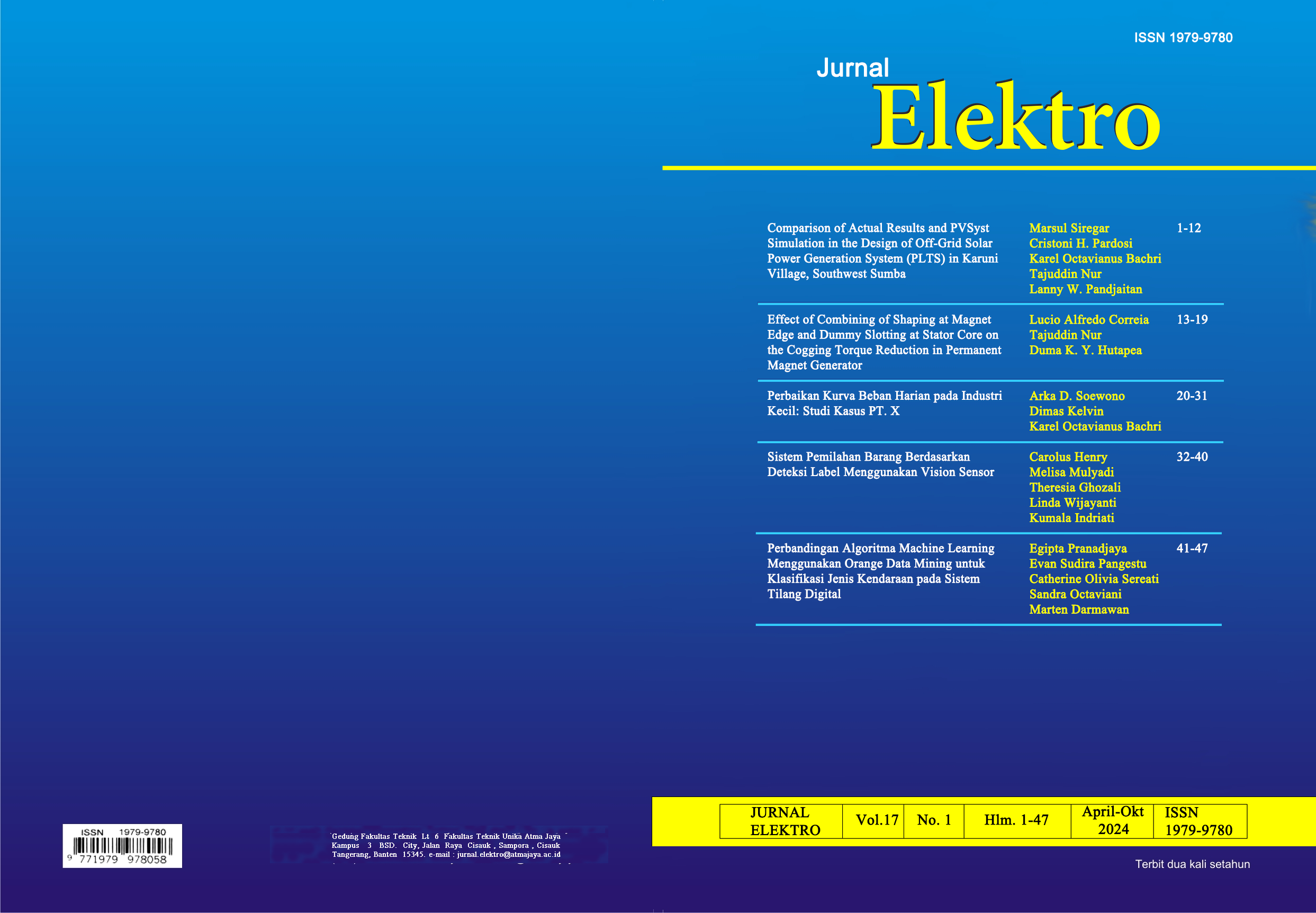Perbandingan Algoritma Machine Learning menggunakan Orange Data Mining untuk Klasifikasi Jenis Kendaraan pada Sistem Tilang Digital
DOI:
https://doi.org/10.25170/jurnalelektro.v17i1.5429Keywords:
Classification of Vehicle Types, Logistic Regression, Neural Network, Orange Data Mining, Support Vector MachineAbstract
This paper discusses the application of the Orange Data Mining application to compare several machine learning algorithms for classifying vehicle types in digital ticket systems. This research compares and analyzes the logistic regression algorithm, Support Vector Machine (SVM) and Neural Network (NN) to solve vehicle classification problems in digital traffic tickets. The research results show that in the training process and based on the dataset used, the algorithms that have the highest level of accuracy are Logistic Regression, Neural Network and Support Vector Machine. Meanwhile, during the testing process, all algorithms in the model were able to carry out classification with 100% accuracy
References
C. O. Sereati, H. R. W. I, C, L. W. Pandjaitan, and M. A. Kartwidjaja, “Music Genre Classification Using Machine Learning Method,” J. Ilm. Tek. Elektro, vol. 21, no. 1, pp. 71–82, 2023, doi: https://doi.org/10.25105/jetri.v21i1.15339.
A. Sentiya and H. Suroyo, “ANALISIS TEXT CLUSTERING AKUN FANPAGE SHOPEE INDONESIA DENGAN KOMENTAR FOLLOWERS MENGGUNAKAN TOOLS ORANGE DATA MINING,” in Bina Darma Conference on Computer Science (BDCCS), 2019, pp. 1055–1067.
D. Vaishnav and B. R. Rao, “Comparison of Machine Learning Algorithms and Fruit Classification using Orange Data Mining Tool,” in 2018 3rd International Conference on Inventive Computation Technologies (ICICT), 2018, pp. 603–607, doi: 10.1109/ICICT43934.2018.9034442.
S. Mittal, C. Monga, A. Bansal, and N. Singla, “Analyzing Data Scientist Salaries Dataset Through Machine Learning Algorithms Using Tool ‘Orange,’” in 2023 7th International Conference On Computing, Communication, Control And Automation (ICCUBEA), 2023, pp. 1–6, doi: 10.1109/ICCUBEA58933.2023.10392037.
N. I. Widiastuti, E. Rainarli, and K. E. Dewi, “Peringkasan dan Support Vector Machine pada Klasifikasi Dokumen,” J. INFOTEL (Informatics,Telecomunication, Electron., vol. 9, no. 4, pp. 416–421, 2017, doi: https://doi.org/10.20895/infotel.v9i4.312.
B. Bakri, M. S. Nuh, and B. Badaru, “Efektifitas Penerapan Program E-Tilang Dalam Mewujudkan Penegakan Hukum Lalu Lintas,” J. LEX THEORY, vol. 1, no. 1, pp. 82–98, 2020, doi: https://doi.org/10.52103/jlt.v1i1.46.
R. Prasetyo, I. Nawawi, A. Fauzi, and G. Ginabila, “Komparasi Algoritma Logistic Regression Dan Random Forest Pada Prediksi Cacat Software,” J. Tek. Inform. Unika St. Thomas, vol. 6, no. 2, pp. 275–281, 2021, doi: 10.54367/jtiust.v6i2.1522.
B. Prihanto, C. O. Sereati, M. A. Kartawidjaja, and M. Siregar, “Atrition Analysis using XG Boost and Support Vector Machine Algorithm,” Int. J. Innov. Sci. Res. Technol., vol. 8, no. 6, pp. 2096–2112, 2023, doi: 10.38124/ijisrt.
M. S. Wibawa, “A Comparison Study Between Deep Learning and Conventional Machine Learning on White Blood Cells Classification,” in 2018 International Conference on Orange Technologies (ICOT), 2018, pp. 1–6, doi: 10.1109/ICOT.2018.8705892.
M. Cheung, J. She, and L. Liu, “Deep learning-based online counterfeit-seller detection,” in IEEE INFOCOM 2018 - IEEE Conference on Computer Communications Workshops (INFOCOM WKSHPS), 2018, pp. 51–56, doi: 10.1109/INFCOMW.2018.8406896.



